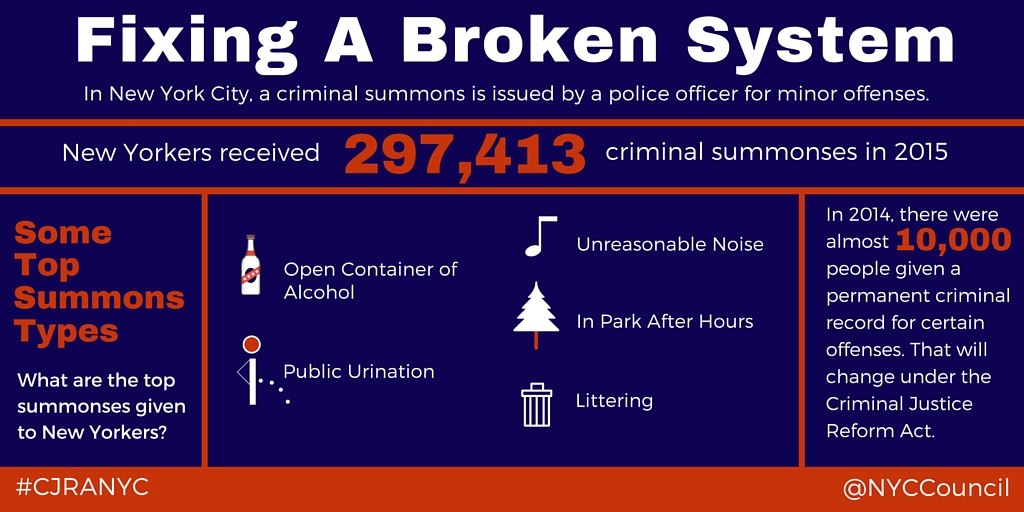In 2015, the NYPD issued over 150,000 criminal summonses for having an open container of alcohol, being in a park after hours, littering, public urination, and unreasonable noise. Some of these summonses gave offenders a permanent criminal record, and missing one court date led to an arrest warrant.
These penalties did not fit the crime. While the offenses remain illegal, the Council has passed a series of laws to solve this problem.
This new legislation sends over 100,000 of these cases to civil court rather than criminal court, saving almost 10,000 people per year from having a permanent criminal record and avoiding over 50,000 warrants every year. Many of the offenses below already had civil penalty options, which were not being issued by the NYPD.
The bills affect the following offenses:
- Open Container of Alcohol
- Parks Rules (being in Park after hours, walking on grass, disobeying signage)
- Littering
- Public Urination
- Unreasonable Noise

Why were people being arrested?
In 2015, New Yorkers received 297,413 criminal summonses for everything from having an open container of alcohol to breaking park rules. That meant that many people were required to take a day off work every year to go to court. And if someone missed their court date, they had an open warrant.
There are 1.5 million open summons warrants in New York. If you have an open warrant and get stopped by the police, you will be detained for approximately 24 hours waiting to go before a judge.
What were the results of these criminal summonses?
From 2003 to 2013, almost two thirds of cases were dismissed. Only 21% of people were found guilty, and the result was almost always a fine. Between 40% and 50% of people with summonses for offenses like open container and parks violations missed their court dates and ended up with an open warrant.
Results of Criminal Summonses 2003-2013
Who does this affect?
Many neighborhoods are impacted by criminal summonses, resulting in a significant number of people with criminal records. Some neighborhoods are impacted more than others.
Neighborhoods that have received the most criminal summonses per resident:
- Canarsie
- Brownsville
- Jamaica
- South Bronx
- East Harlem
- Mott Haven
- Port Morris
- Hunts Point
Residents in low-income neighborhoods have been more likely to receive criminal summonses. In 2015, the top summons in each of these neighborhoods was Open Container of Alcohol.
What is the Difference between Criminal and Civil Court Summonses?
Criminal Court Summonses:
- A person may receive a permanent criminal record for some criminal summonses.
- A criminal summons requires a personal court appearance in almost all cases.
- A warrant will be issued if a person does not appear in criminal court. The warrant rate in criminal court for these offenses is between 40% and 50%, resulting in over 1.5 million active summons warrants in the City.
Civil Court Summonses:
- A person will not receive a permanent criminal record for civil summonses.
- Fines can be paid online and appearances can be made by phone.
- A warrant will not be issued if a person does not appear in civil court.
- The rate of fines being imposed in civil court is higher than criminal summons.
